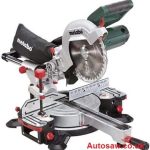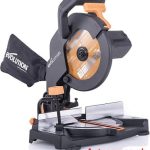As an Amazon Associate, I earn from qualifying purchases.
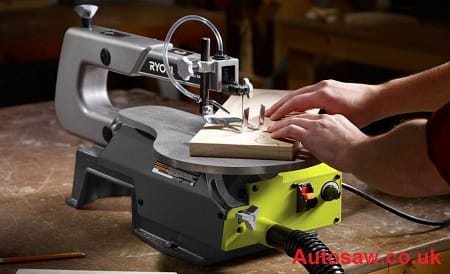
Scroll saws are a versatile tool that can be used to create intricate designs in wood, metal, and other materials. Whether you are a professional woodworker or a hobbyist, a scroll saw can be a valuable addition to your workshop. In this article, we will discuss how to use a scroll saw, including tips and techniques for getting the most out of this powerful tool.
Contents
- What is a Scroll Saw?
- How To Use A Scroll Saw?
- Choosing the Right Scroll Saw
- Understanding the Anatomy of a Scroll Saw
- Selecting the Right Blade
- Installing and Tensioning the Blade
- Adjusting the Speed and Stroke Length
- Starting and Stopping the Scroll Saw
- Cutting Straight Lines
- Cutting Curves and Angles
- Making Internal Cuts
- Creating Compound Cuts
- Using Scroll Saw Patterns
- Maintenance and Safety Tips
- Common Scroll Saw Problems and Solutions
- Tips For Using A Scroll Saw
- Common Techniques For Using A Scroll Saw
What is a Scroll Saw?
A scroll saw is a specialized tool that is used to make intricate cuts in wood, metal, plastic, and other materials. The blade of a scroll saw is thin and narrow, allowing it to cut intricate shapes and curves with precision. The saw’s table is usually tilted, which allows the user to make angled cuts as well. Scroll saws are available in a variety of sizes, from small hobbyist models to large industrial machines.
How To Use A Scroll Saw?
A scroll saw is a specialized saw that is used to make intricate cuts and designs in a variety of materials, including wood, metal, and plastic. Unlike other saws, a scroll saw can make curved cuts with ease, making it a favorite among woodworkers, hobbyists, and DIY enthusiasts. With a scroll saw, you can create intricate designs and patterns, and even make internal cuts, which is impossible with other saws.
Choosing the Right Scroll Saw
When it comes to choosing the right scroll saw, there are several factors to consider, including the type of work you’ll be doing, your budget, and the features you need. Some of the key factors to consider include the size of the saw, the type of blade it uses, the power and speed of the motor, and the type of materials you’ll be working with.
Understanding the Anatomy of a Scroll Saw
Before you can start using a scroll saw, it’s important to understand the different parts of the saw and their functions. Some of the key components of a scroll saw include the table, blade, blade holder, tension knob, speed control, and dust blower. Understanding how each of these parts works will help you use the saw more effectively and safely.
Selecting the Right Blade
The type of blade you choose will depend on the type of material you’ll be cutting and the level of detail you want to achieve. Scroll saw blades come in a variety of sizes and types, including skip-tooth, double-tooth, and spiral blades. Understanding the differences between these blades will help you choose the right one for your project.
Installing and Tensioning the Blade
Once you’ve selected the right blade, it’s time to install and tension it. This process involves inserting the blade into the blade holder and using the tension knob to adjust the tension. Proper tensioning is essential for achieving clean, precise cuts.
Adjusting the Speed and Stroke Length
Most scroll saws come with adjustable speed and stroke length settings. These settings allow you to adjust the speed and stroke length of the blade based on the type of material you’re cutting and the level of detail you want to achieve.
Starting and Stopping the Scroll Saw
Before you start using the scroll saw, it’s important to understand how to start and stop it safely. This involves ensuring that the blade is properly tensioned and that the material you’re cutting is securely fastened to the table. You should also be familiar with the power switch and how to turn the saw on and off safely.
Cutting Straight Lines
To cut straight lines with a scroll saw, you’ll need to use a guide or follow a marked line on the material. Start by positioning the material on the table and aligning it with the blade. Then, turn on the saw and slowly guide the material through the blade, making sure to keep it straight and steady. Remember to use a slow and steady pace, and let the blade do the cutting.
Cutting Curves and Angles
One of the main benefits of using a scroll saw is the ability to cut curves and angles with ease. To cut curves, start by drilling a hole in the material where you want to make the cut. Then, insert the blade into the hole and slowly guide the material through the blade, following the curve. To cut angles, tilt the table of the saw to the desired angle and adjust the blade accordingly.
Making Internal Cuts
Internal cuts are cuts made in the middle of the material, without an external edge to guide the blade. To make internal cuts, you’ll need to drill a hole in the material and insert the blade into the hole. Then, slowly guide the blade through the material, making sure to follow the desired pattern. Remember to take your time and use a slow and steady pace.
Creating Compound Cuts
Compound cuts are cuts that involve multiple angles and curves. To create compound cuts, you’ll need to make a series of cuts, each at a different angle or curve, and then fit them together like a puzzle. This requires patience, skill, and a good eye for detail.
Using Scroll Saw Patterns
Scroll saw patterns are pre-made designs that can be used as a guide for cutting intricate shapes and patterns. These patterns can be found online or in books, and can be printed out and attached to the material using adhesive. Following a pattern can help you create precise and intricate designs with ease.
Maintenance and Safety Tips
To keep your scroll saw in good working condition, it’s important to perform regular maintenance and safety checks. This includes keeping the blade clean and sharp, adjusting the tension and speed settings as needed, and ensuring that all safety features are in place and working properly.
Common Scroll Saw Problems and Solutions
Like any tool, scroll saws can experience problems from time to time. Some of the most common problems include blade breakage, blade wandering, and burning of the material. These problems can usually be resolved by adjusting the tension, speed, and stroke length settings, or by replacing the blade.
Tips For Using A Scroll Saw
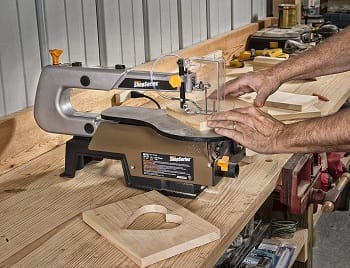
Choose the Right Blade
One of the most important factors in using a scroll saw is choosing the right blade. The blade you use will depend on the material you are cutting and the type of cut you want to make. For example, a coarse blade is best for cutting thick wood, while a fine blade is better for intricate designs in thinner materials.
Secure the Material
To use a scroll saw safely and effectively, you must secure the material you are cutting. This can be done by using clamps, vises, or other types of holding devices. Make sure the material is firmly secured before you start cutting.
Wear Protective Gear
When using a scroll saw, it is important to wear protective gear, including safety glasses and earplugs. This will protect your eyes and ears from debris and noise generated by the saw.
Start Slowly
When you are first learning how to use a scroll saw, it is best to start slowly. This will give you a chance to get used to the saw’s movements and make precise cuts. As you become more comfortable with the saw, you can increase the speed and complexity of your cuts.
Practice
As with any new tool or skill, practice is essential. Take the time to practice different types of cuts and techniques on scrap material before you start on your actual project. This will help you become more familiar with the saw and its capabilities.
Common Techniques For Using A Scroll Saw
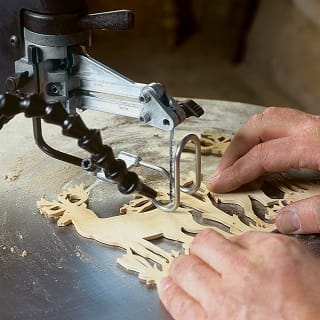
Straight Cuts
To make straight cuts with a scroll saw, you will need to use a guide or a fence. This will help you keep the blade on track and ensure a straight cut.
Inside Cuts
Inside cuts are used to create holes or shapes in the middle of a piece of material. To make an inside cut, you will need to drill a starter hole and then thread the blade through the hole.
Outside Cuts
Outside cuts are used to cut shapes or designs on the outside of a piece of material. To make an outside cut, you will need to start at the edge of the material and carefully guide the saw along the desired path.
Bevel Cuts
Bevel cuts are made at an angle, which allows you to create angled edges or designs in your material. To make a bevel cut, you will need to adjust the angle of the saw’s table and guide the material through the blade.
Conclusion
Using a scroll saw can be a rewarding and enjoyable experience, whether you are a professional woodworker or a hobbyist. By following these tips and techniques, you can get the most out of your saw and create intricate designs with precision and ease. Remember to wear protective gear, start slowly, and practice regularly to become a skilled scroll saw user. With a little time and effort, you can master this versatile tool and take your woodworking skills to the next level.
